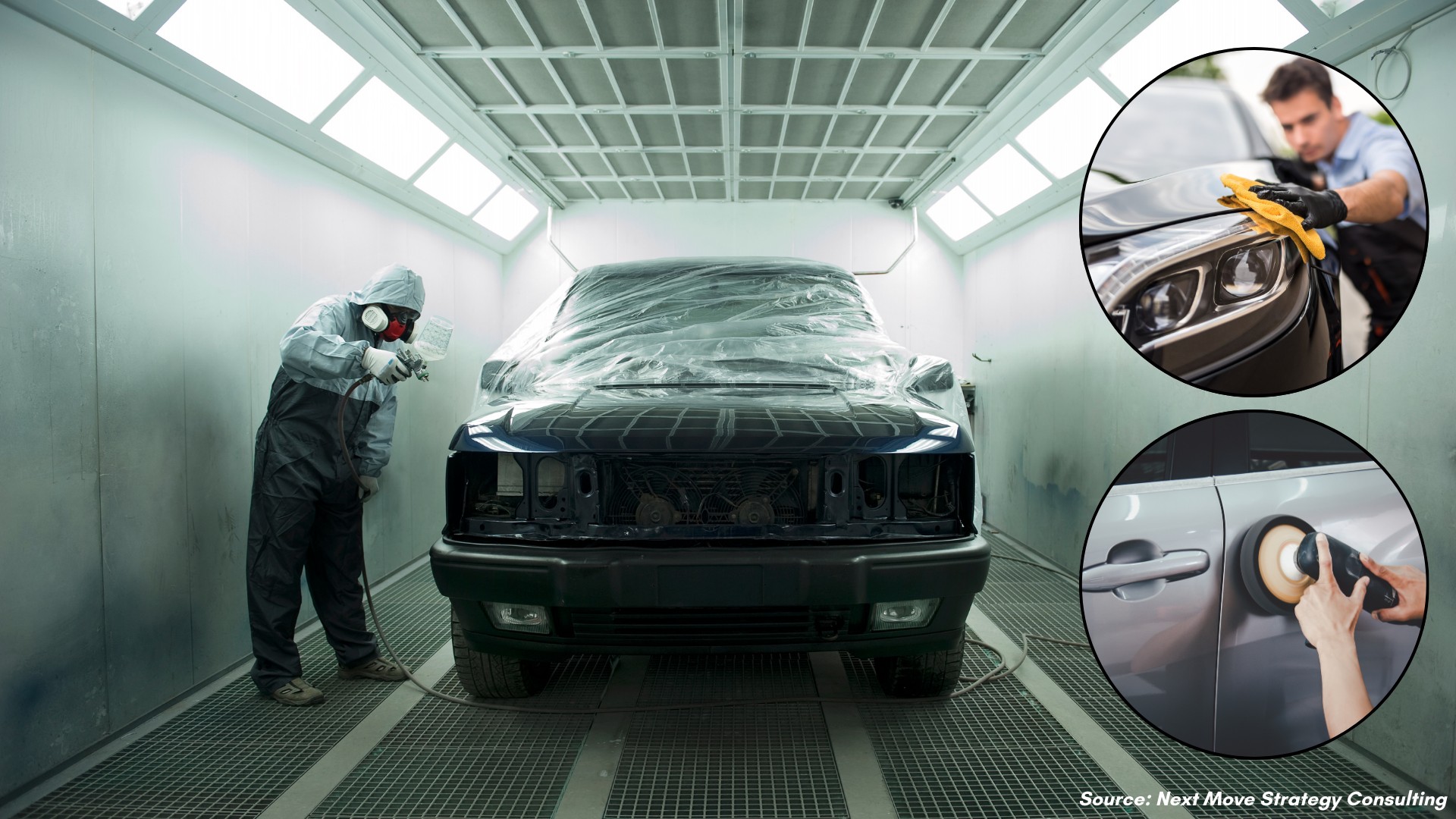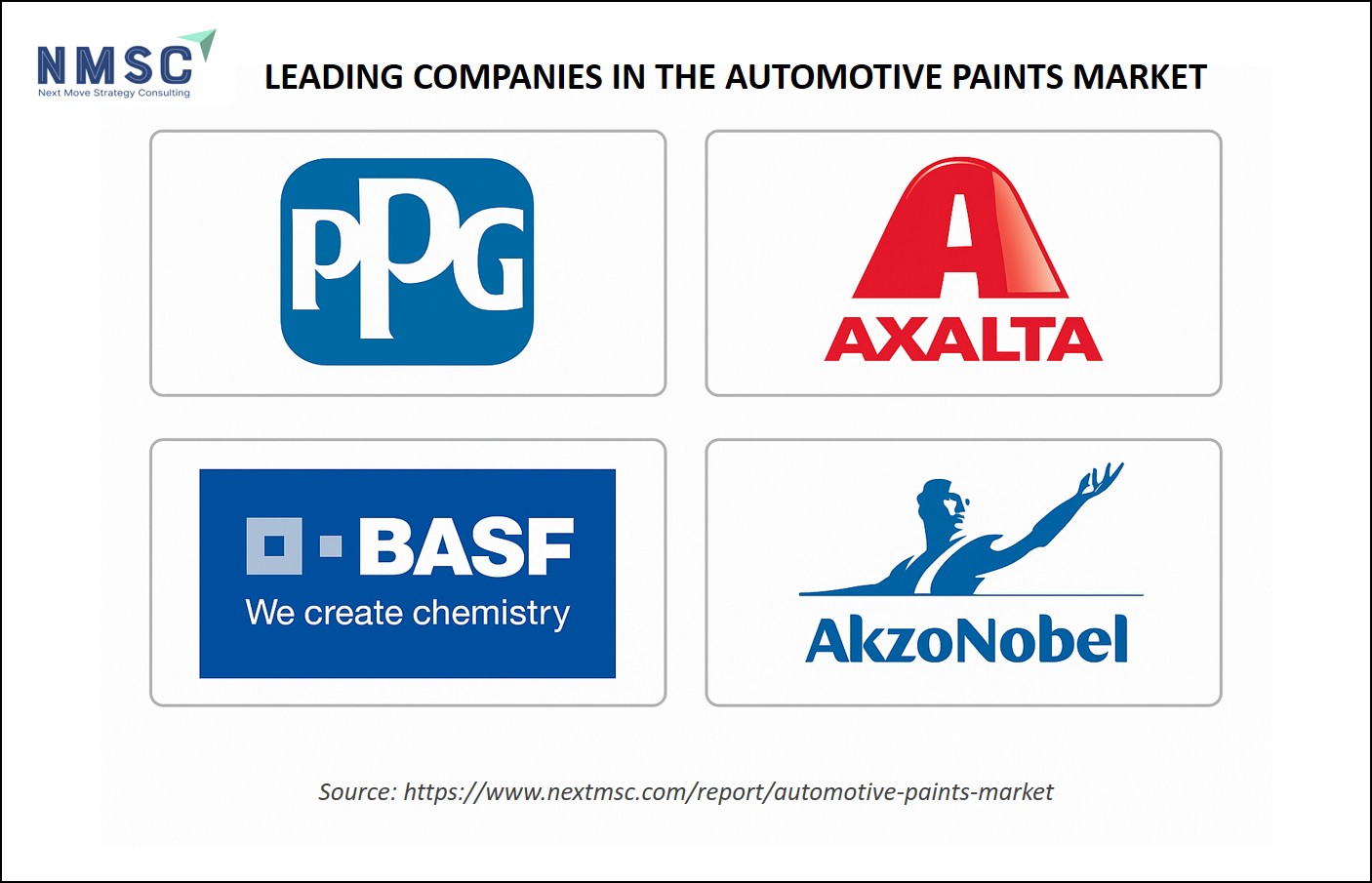Leading Players’ Strategies in the Automotive Paints Market
Published: 2025-09-10

The Automotive Paints Market is a dynamic and rapidly evolving sector, driven by innovation, sustainability demands, and increasing global vehicle production. This market is projected to reach USD 11.49 billion with a CAGR of 5.4%, growing significantly by 2030, fueled by the rise of electric vehicles (EVs), stricter environmental regulations, and consumer demand for aesthetic customization. Major players like PPG Industries, Axalta Coating Systems, BASF SE, and Akzo Nobel N.V. are shaping the industry through strategic initiatives.
Strategic Focus of Leading Players
1. Innovation in Eco-Friendly Coatings
Environmental regulations, particularly volatile organic compound (VOC) emission standards, are pushing companies to develop sustainable solutions.
-
PPG Industries: PPG launched its ENVIRO-PRIME® EPIC 200R electrocoat (e-coat) products that cure at lower temperatures than competing technologies. The products provide sustainability benefits for customers, including lower energy use and reduced CO2 emissions at manufacturing facilities. The platform delivers well-cured films at reduced baking temperatures, offering a sustainable solution while maintaining manufacturing efficiency and coating quality. PPG’s growth strategy emphasizes collaboration with customers to deliver cutting-edge innovations and digital solutions that enhance productivity and sustainability.
-
BASF SE: BASF introduced a new generation of clearcoats in April, 2024 for the Asia Pacific refinish market, offering a new portfolio of eco-efficient clearcoats and undercoats that offers higher quality and increased productivity, contributing to significant reduction in CO2 emissions.
-
Akzo Nobel N.V.: Akzo Nobel’s 2024 sustainability report highlights its commitment to use water as a raw material in (waterborne) paints and coatings (10% of water use in 2024), as well as for general household and sanitation purposes, such as cleaning. started a unique collaboration with two industry-leading raw material suppliers to explore how existing formulation practices can be enhanced to significantly reduce the carbon footprint of decorative wall paint. The company aims in reducing carbon footprints carbon footprint through energy efficiency improvements and renewable energy sources.
2. Strategic Partnerships and Collaborations
Collaborations with automotive manufacturers are critical for market expansion. These partnerships enable companies to tailor solutions for specific vehicle types, especially EVs and luxury models.
-
BASF and INEOS Automotive: In February 2024, BASF’s Coatings Division signed a global partnership agreement with INEOS Automotive on a global automotive refinish body and paint development:
-
The partnership includes the supply of sustainable refinish solutions, expertise and latest digital color-matching solutions and training.
-
This partnership strengthens BASF’s position in Europe, North America & Asia-Pacific. “With BASF’s technical support and management experience in the latest body shop standards, the INEOS Automotive network can now rely on a partner that shares our commitment to excellence in customer service.”
-
BASF will ensure that the most sustainable and efficient refinish practices are maintained at the highest level to the INEOS body shop network in Europe, North America, and Asia Pacific.
-
-
Axalta Coating Systems: Axalta partnered with BMW in 2024 as a preferred refinish supplier for BMW Group in regions where BMW’s private label, ColorSystem, is unavailable. Effective January 2025, this multi-year agreement covers BMW Group’s dealerships and collision repair shops across more than 50 countries worldwide.
-
BMW Group has also renewed Axalta’s role as a ColorSystem supplier in the US and China, following its established position as the exclusive ColorSystem provider in Europe and South Africa. BMW’s ColorSystem is recognized as one of the world’s most advanced paint systems.
-
“Axalta has consistently met BMW Group’s rigorous standards for quality, efficiency, and sustainability through multiple tender processes,” said Fabien Boschetti, Axalta Refinish Sales Vice President for Europe.
-
Axalta will further provide its patented Fast Cure Low Energy technology paint system, which reduces carbon emissions and energy use, alongside industry-leading training support.
-
-
PPG Industries: PPG in May, Germany, announced that it will showcase its total system solutions for electric vehicle (EV) battery packs at The Battery Show Europe, taking place June 3-5 at the Messe Stuttgart exhibition center:
-
The 2024 PPG RAYCRON® Dielectric UV and PPG ENVIROCRON® Dielectric Powder technology platforms, PPG Envirocron PCM 50120 flame retardant powder coating and PPG CORAGUARD™ SE 5300 anti-blast fire protection, representing the latest advancements in EV battery pack safety and protection.
-
“At PPG, we are committed to driving automotive excellence,” said David Fetterman, PPG global market director electrification, adhesives and sealants, Automotive OEM Coatings.
-
PPG’s worldwide manufacturing network and partnerships with OEMs and Tier suppliers allow the company to tailor coating solutions to meet specific needs, delivering reliable application, consistent quality, complete process support, and comprehensive service from a single provider.
-
3. Investment in Research and Development
Leading players are heavily investing in R&D to develop advanced coatings with features like self-healing, anti-glare, and temperature regulation. These innovations cater to consumer demand for durability and aesthetics.
-
PPG Industries: PPG allocated USD 1.5 billion to R&D in 2024, focusing on smart coatings with self-healing properties for luxury vehicles. Source: PPG 2024 10-K Filing
-
Akzo Nobel N.V.: More than $30 million is being invested by AkzoNobel to install advanced technologies and increase total manufacturing capacity at its four powder coatings sites in North America. The company is implementing new extruders, thermoplastics, and bonding processes at its plants in Reading, Pennsylvania; Warsaw, Indiana; Nashville, Tennessee; and Monterrey, Mexico. These upgrades will drive multiple benefits, including enhanced production efficiency and broader application capabilities.
-
BASF SE: BASF’s investments in research and development in 2024 amounted to €2.1 billion. For 2025, the company is planning a similarly high budget for research and development. “Innovations are key to achieving the goals of our new ‘Winning Ways’ strategy. The company’s R&D efforts will prioritize technologies that advance the green transformation, focusing on areas like biodegradable materials, sustainable value chain processes, and innovative solutions for the plastic circular economy. Additionally, BASF will expedite its digital transformation by leveraging digital tools in R&D to accelerate the development and market introduction of advanced technologies.
4. Geographic Expansion in High-Growth Regions
Asia Pacific, with its booming automotive sector, is a focal point for expansion. This dominance is attributed to the remarkable expansion in automobile manufacturing, particularly in countries such as India, China, and Japan that significantly increases the automobile paints market demand.
-
India: India’s automotive industry is a vital pillar of the nation’s economy, contributing 7.1% to GDP and 49% to manufacturing GDP, and ranks as the world’s fourth-largest automobile producer, with over 28 million vehicles manufactured till 24. With targeted reforms and investments, India has the potential to triple its auto component exports to $60 billion, achieve a $25 billion trade surplus, and create 2–2.5 million direct jobs by 2030, establishing itself as a globally competitive, innovation-driven manufacturing hub.
-
China: China's auto production and sales both surpassed 15 million units for the first time in the first half of 2025, with new-energy vehicles (NEVs) leading the growth. In the first half of 2025, China’s auto industry saw robust growth, with vehicle production reaching 15.62 million units, up 12.5% year-on-year, and sales hitting 15.65 million, up 11.4%, both surpassing 15 million for the first time in this period, per CAAM data. With improved transport capacity, Chinese carmakers can now deliver larger volumes of vehicles to overseas ports more efficiently and sell them at relatively competitive prices, driving substantial sales growth, he said.
-
Japan: Japan is home to some of the world’s largest automobile manufacturers, including Toyota, Honda, Nissan, among others.
|
Company |
Highlights |
Key Contributions |
|
Toyota |
Largest automaker globally by volume |
Innovator in hybrid technology (e.g., Prius); sets global quality and environmental benchmarks |
|
Honda |
Diverse lineup from motorcycles to luxury cars |
Renowned for engineering excellence and design leadership |
|
Nissan |
Pioneer in electric vehicles (EVs) |
Introduced the Nissan Leaf, advancing sustainable transportation |
Other notable players include Suzuki, Subaru, and Mazda, all of which contribute to Japan’s global automotive footprint. Japanese automakers have also set up production facilities worldwide, from North America to Southeast Asia, creating jobs and fostering technological exchange. This global integration underscores their influence in shaping the modern automobile industry.
Challenges and Opportunities
Stringent environmental regulations limit the use of traditional solvent based paints due to their high VOC (Volatile Organic Compounds). These regulations push the manufacturers to invest in research and development of eco-friendly alternatives, thus restraining the automotive paints market expansion.
Opportunities:
-
Rising vehicles production drives demand for high-quality, durable, and aesthetically appealing paint solutions, thereby driving the automotive paints market growth.
-
Advancement in coating technologies, particularly, innovations in paint formulation and the development of water-borne and UV-borne coatings, is significantly propelling the automobile paints market growth.
-
Introduction of sustainable and eco-friendly coatings is expected to create ample opportunities for the market.
Next Steps: Actionable Takeaways for Stakeholders
To leverage opportunities in the automotive paints market, stakeholders can adopt the following strategies:
-
Invest in Sustainable Technologies: Focus on waterborne and powder coatings to meet regulatory standards and consumer demand for eco-friendly products.
-
Forge Strategic Partnerships: Collaborate with automakers to develop tailored solutions, particularly for EVs and luxury vehicles.
-
Expand in Asia Pacific: Prioritize investments in high-growth markets like China and India to capture market share.
-
Enhance R&D Efforts: Allocate resources to develop smart coatings with advanced features like self-healing and UV resistance.
-
Monitor Regulatory Changes: Stay updated on VOC and environmental regulations to ensure compliance and avoid penalties.
Conclusion
As the global automotive industry embraces electrification, sustainability, and next-gen vehicle designs, the automotive paints market stands at a transformative crossroads. Innovations in eco-friendly coatings, smart technologies, and collaborative partnerships with leading automakers are reshaping how vehicles are finished and protected.
With strategic investments in R&D and targeted expansions into fast-growing regions like Asia Pacific, key players are positioning themselves to meet evolving consumer preferences and regulatory demands. Looking ahead, success in this sector will depend on a company’s ability to balance performance, environmental responsibility, and aesthetic appeal—making innovation not just an option, but a necessity.
About the Author
 Sneha Chakraborty is a seasoned SEO Executive and Content Writer with over 4 years of experience in the digital marketing space, bringing a strong command of online visibility strategies and a keen insight into the evolving digital landscape. She specializes in enhancing online visibility and user engagement through data-driven strategies and creative content solutions. Sneha is passionate about translating complex digital concepts into accessible content for a wide audience. Outside of work, she enjoys reading, sketching, and exploring the outdoors through nature photography.
Sneha Chakraborty is a seasoned SEO Executive and Content Writer with over 4 years of experience in the digital marketing space, bringing a strong command of online visibility strategies and a keen insight into the evolving digital landscape. She specializes in enhancing online visibility and user engagement through data-driven strategies and creative content solutions. Sneha is passionate about translating complex digital concepts into accessible content for a wide audience. Outside of work, she enjoys reading, sketching, and exploring the outdoors through nature photography.
About the Reviewer
 Debashree Dey is a skilled Content Writer, PR Specialist, and Assistant Manager with strong expertise in Digital Marketing. She specializes in crafting visibility strategies and delivering impactful, data-driven campaigns. Passionate about creating engaging, audience-focused content, she helps brands strengthen their online presence. Beyond work, she draws inspiration from creative projects and design pursuits.
Debashree Dey is a skilled Content Writer, PR Specialist, and Assistant Manager with strong expertise in Digital Marketing. She specializes in crafting visibility strategies and delivering impactful, data-driven campaigns. Passionate about creating engaging, audience-focused content, she helps brands strengthen their online presence. Beyond work, she draws inspiration from creative projects and design pursuits.















Add Comment